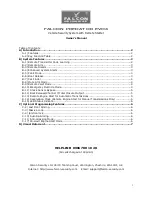
MAN3184 - TITANUS PRO
•
SENS®
92
5.3.6 Project planning for forced airflow
Air conditioning duct
monitoring
Air conditioning systems are distinguished between high-speed and low-
speed systems. The information listed in this section only applies to low-
speed systems. There are insufficient empirical values for high-speed
systems. For that reason, smoke tests are to be conducted with air
conditioning ducts having flow rates higher than 10 m/s and the optimum
response characteristics are to be determined.
Low-speed systems
High-speed systems
Flow speed [m/s]
Max. 6 to 10
> 10
Duct cross-section
High
Low
Pressure differential along the
direction of flow
Low
High
The rate distribution in an air conditioning duct looks like this:
Figure 58:
Speed distribution in an air conditioning duct
Aspiration
The pipe system must be arranged in area V
1
to V
3
to achieve optimum
detection results.
Installation location of the
pipe system
As installation location for the pipe system, the air exhaust duct is to be
chosen. The installation location must be as far away as possible from
silencers, air baffles and bends. The reference value for the distance from
"obstacles" is: at least 3x minimum duct diameter.
If it is absolutely necessary to attach the pipe system directly behind baffles,
silencers or elbows, the main flow speed areas are to be monitored.
Summary of Contents for Ampac TITANUS PRO-SENS
Page 51: ...MAN3184 TITANUS PRO SENS 51 Figure 34 Pipe shapes...
Page 61: ...MAN3184 TITANUS PRO SENS 61 Figure 36 Example pipe project planning with pipe accessories...
Page 118: ...MAN3184 TITANUS PRO SENS 118 Figure 73 Drill hole intervals for bracket type MT 1 mm...
Page 135: ...MAN3184 TITANUS PRO SENS 135 Figure 84 Attaching the aspiration reducing film sheet...
















































